Features of installing a washing machine in the toilet
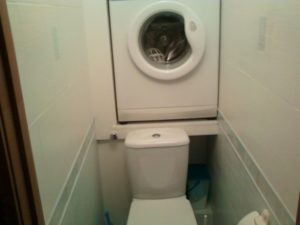 Approximately a third of the country's residents live in very cramped living conditions: a small kitchen, separate toilets and bathrooms of minimal size, and small living rooms or a room. Where to place the washing machine in such conditions, in the kitchen, where it’s impossible to turn around anyway, or maybe in the bathroom? There is an original idea according to which the washing machine can be placed above the toilet in the toilet. But such placement has a lot of nuances, which we will talk about in this publication.
Approximately a third of the country's residents live in very cramped living conditions: a small kitchen, separate toilets and bathrooms of minimal size, and small living rooms or a room. Where to place the washing machine in such conditions, in the kitchen, where it’s impossible to turn around anyway, or maybe in the bathroom? There is an original idea according to which the washing machine can be placed above the toilet in the toilet. But such placement has a lot of nuances, which we will talk about in this publication.
Preparing a place for the machine
A washing machine in the restroom above the toilet is, in fact, a necessary measure. Experts admit that it is necessary to place the washing machine in the toilet only if there is no way to place it in the bathroom or kitchen. Why is that?
- Installing a heavy washing machine in the very narrow space of a Khrushchev toilet is very problematic.
- Preparing a reliable shelf for a washing machine above the toilet also poses some difficulties.
- Operating a machine in the toilet also has disadvantages, just imagine how to “do business” very close to a wringing vibrating washing machine.
- And finally, what should you do with the machine installed in the toilet if it suddenly breaks down? Even with a minor breakdown, the washing machine will have to be removed from the shelf, repaired, and then put back - a job for a weightlifter.
But let’s not talk about sad things, since you decided to install such an “iron assistant”, it means you had reasons for it. Let's start preparing the installation site. First you need to decide on the sizes.Measure the back wall of your toilet, we will need a minimum of 66cm of clearance in width and 85cm in height. Be sure to consider the location of sewer and water pipes.
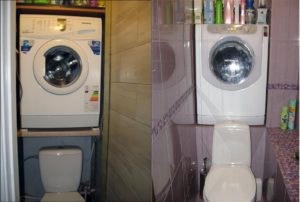 It is preferable to install narrow washing machines above the barrel, since washers of standard depth often protrude forward, as if hanging over the toilet. It is unlikely that anyone will want to “bend like a panther” in their own home to relieve themselves or bother with moving the toilet forward, although the second option is quite possible.
It is preferable to install narrow washing machines above the barrel, since washers of standard depth often protrude forward, as if hanging over the toilet. It is unlikely that anyone will want to “bend like a panther” in their own home to relieve themselves or bother with moving the toilet forward, although the second option is quite possible.
So, measurements of the width, depth and height have been made, the place for the washing machine has been determined, let's proceed to the construction of the load-bearing part of our shelf. Our experts recommend making the load-bearing part from a forty metal corner. The wooden structure will not withstand a heavy, vibrating washing machine. We do the following:
- We cut the fortieth corner three times by 60 cm, twice by 45 cm (provided that the washer is not 60 cm wide) and twice by 55 cm.
- We screw a 60 cm piece of corner to the wall at a level just above the toilet cistern, screw another similar piece to the wall parallel to the first, 45 cm lower.
- To the first screwed corner we weld two short corners of 45 cm each perpendicularly, and then connect them with a piece of a 60 cm corner - we get a frame.
- We strengthen the frame with supports from 55 cm corners, welded diagonally from the lower wall corner to the corners of the frame.
For your information! We got a heavy-duty steel shelf that can support five times the weight of an average washing machine.
Connecting to communications
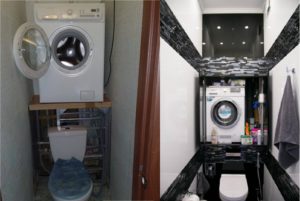 Let’s leave the structure for a while and start organizing communications for the future washing machine. Let's start with electrics. The washing machine must be connected to a high-quality moisture-resistant outlet; almost no one has such outlets in the toilet, so our task is to remove it.
Let’s leave the structure for a while and start organizing communications for the future washing machine. Let's start with electrics. The washing machine must be connected to a high-quality moisture-resistant outlet; almost no one has such outlets in the toilet, so our task is to remove it.
We pull a well-insulated three-core 2.5 mm copper wire from the shield, screw a moisture-resistant socket into a convenient place, enclose the wire in a cable channel, and connect it through the machine to the socket. Let's check how the socket works. Next, let's connect to cold water, do the following:
- turn off the cold water using the valve installed on the riser;
- we cut the metal-plastic pipe and place a jumper in this place in the form of a tee tap;
- We screw the inlet hose of the washing machine to the tap tee and leave everything as is for a while.
Now you need to take care of creating a connection to the sewer. Connecting the washing machine to the sewer is described in detail in the article of the same name on our website; all technical requirements for this process must be met. In addition, care must be taken to ensure that the outlet of the sewer pipe is at a sufficient height to avoid a siphon effect.
Note! The siphon effect occurs when the drain hose is connected incorrectly, and sewage from the sewer flows into the washing machine.
Now that communications are organized, we can “finish up” our shelf and install a washing machine on it. First of all, we will take care of safety; we will weld a 5 cm wide metal strip to our front shelf, in case the machine “wants to jump forward” during operation. Then you can decorate the shelf as you please, one of the options is to cover it with plasterboard, plaster and paint, the choice is yours.Don’t be afraid that the finishing material will bounce off due to vibration; the structure is quite rigid, so you shouldn’t expect such troubles.
The main work is done. Next, you need to gather your strength and “short-circuit” the washing machine to the shelf and connect it to water, sewerage and electricity. It is very difficult and inconvenient. The washing machine can weigh 80 kg, it takes two people to lift it, and in a narrow toilet it’s hard to turn around even alone, but as they say, “the master’s work is afraid.”
Having placed the machine on the shelf, we screw the pre-prepared water supply hose and drain hose to it and connect it to the outlet. Time to run a test wash - job done.
What to do if the machine breaks down?
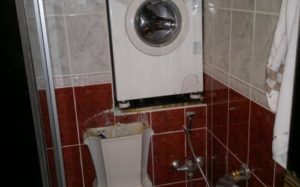 Any washing machine does not last forever, this is clear to everyone. If a washing machine standing on a shelf in the toilet becomes damaged, which requires disassembling it, you will have to first turn off the machine, and then remove it from the shelf, repair it and put it back. Our masters have experience in such manipulations, so they advise To make it easier to move the machine, bring it into the toilet sideways and also lift it sideways onto the shelf. It is much easier to then turn it around on the shelf with its front side and put it towards you, than to “wiggle it backwards”.
Any washing machine does not last forever, this is clear to everyone. If a washing machine standing on a shelf in the toilet becomes damaged, which requires disassembling it, you will have to first turn off the machine, and then remove it from the shelf, repair it and put it back. Our masters have experience in such manipulations, so they advise To make it easier to move the machine, bring it into the toilet sideways and also lift it sideways onto the shelf. It is much easier to then turn it around on the shelf with its front side and put it towards you, than to “wiggle it backwards”.
To summarize, we note that no matter how attractive the idea of installing a washing machine in the toilet above the toilet may seem to you, implement it only as a last resort, when all other options are discarded. This installation option has many disadvantages, although it significantly saves usable space in your apartment or house.
Interesting:
Reader comments
- Share your opinion - leave a comment

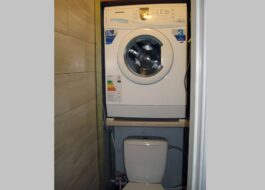



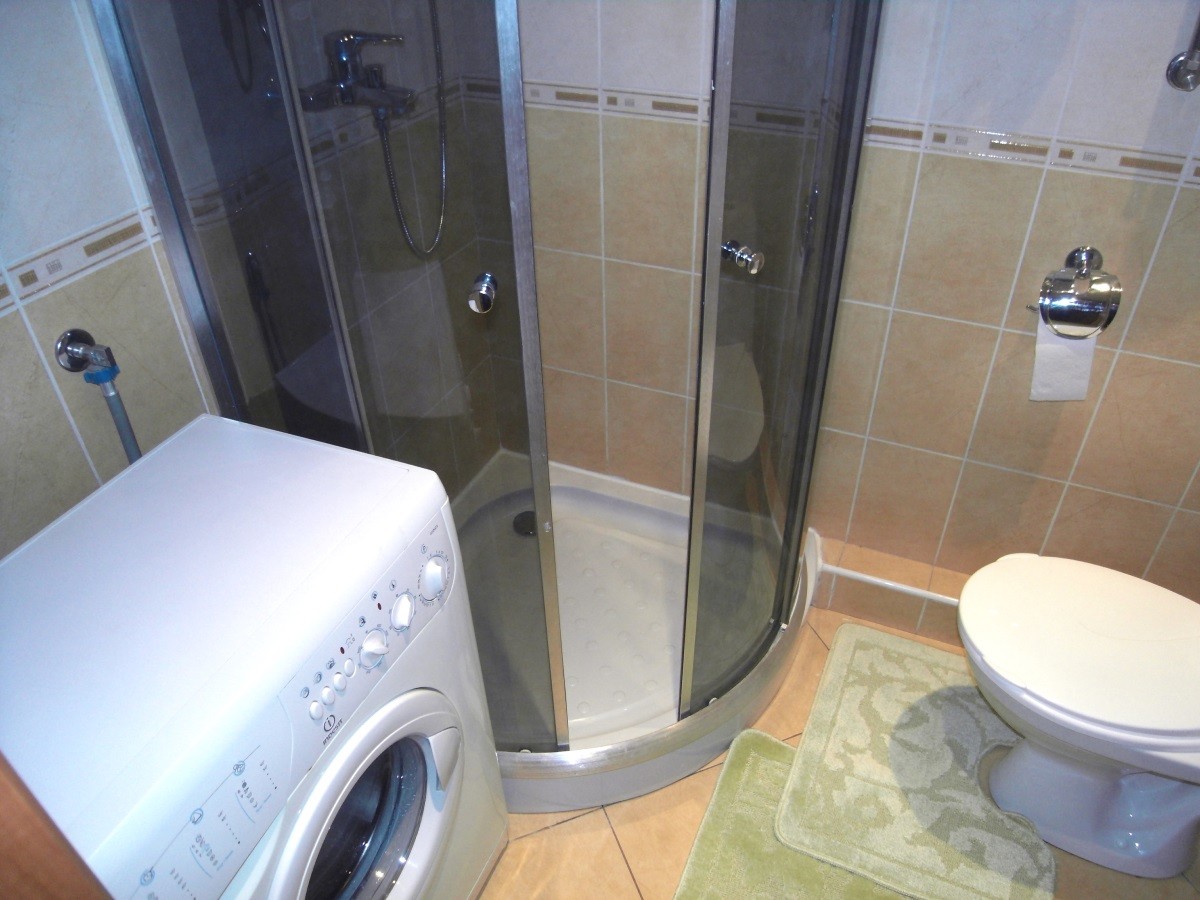
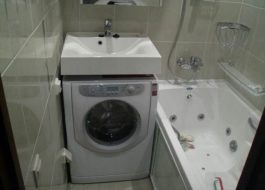














Add a comment